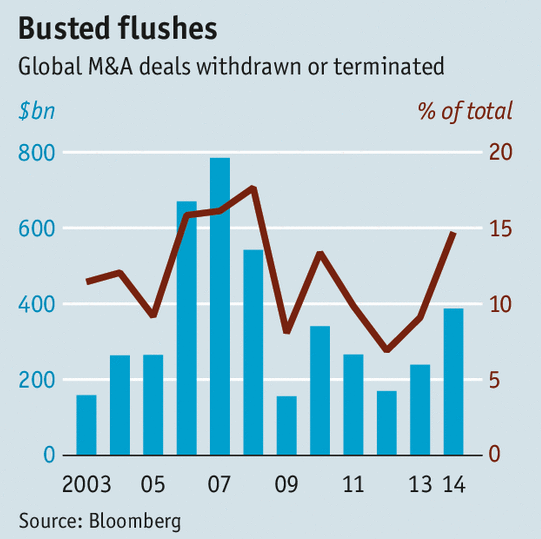M&A Blog #02 – success / failure, metrics, drivers, and ties to corporate strategy
In the last blog post, we discussed that 85% of tracked M&A deals failed. Failure is defined as a return on investment (ROI) that does not meet or exceed costs of capital. Depending on the acquisition, this bar can be relatively low compare to other corporate growth tools. A majority of M&A deals actually do create value for the acquirers, although the ROI are modest relative to capital costs. One can think of M&A as a reverse casino. Instead of a few people winning loudly with bells and lights surrounded by silent losers, M&A winners quietly capture incremental returns over their cost of capital. In this post, we will discuss M&A success and failure, metrics and drivers for each, and ties to corporate strategy.
How do we measure M&A success? By choosing the most appropriate metrics and comparisons. It is most important that acquirers understand their own companies’ value drivers before approaching a target. It would make determining value creation in the target much easier. The most commonly chosen metrics are: vague combinations of earnings-EBIT-EBITDA, growth rates, cash flows, book values, dividends, buybacks, trading volumes, and investor relations. It is too often that the focus is on accounting numbers – which may have a limited relationship to underlying cash flows. A basic yardstick for an acquisition pre- and post-transaction, such as P/E ratio, is appealing because it is simple and makes it easy to compare companies across time periods.
Accounting-based comparisons have limitations that may lead to misleading inaccuracies, such as:
Balance sheet issues are minimized
An emphasis on accounting measures, rather than cash flows
Earnings manipulation
Quality of earnings and associated risks are ignored
Rather, a more holistic approach should be deployed; taking into account cash flows over time, risks of those cash flows, and investments required to secure them.
An M&A deal has only three possible outcomes:
Success: value is created through ROI higher than those required by investors (there is an excess of the capital’s opportunity costs)
Failure: value is destroyed through ROI lower than those required
Neutral: value is conserved through ROI that is the same as required return
Other success metrics include: EPS (earnings per share) accretion, favorable analyst reviews, increased trading activity, a diversified revenue stream, and reduced earnings volatility. It is important to note that an M&A deal can create interest and spike in trading of acquirer’s shares, but this will not translate into anything more if the deal doesn’t increase shareholder value. Further, an over reliance on accounting metrics may lead to acquisitions that look good on paper, but doesn’t translate into return-adjusted cash flow. This is the reason why acquirers must consistently adjust for actual cash flow effects. We will discuss this element in detail when we discuss valuation – especially DCF (Discounted Cash Flow) method.
There are three drivers to M&A success:
1. Careful alignment with company’s overall strategy
Proactive acquisitions (as opposed to reactive) lead to add-on targets that further corporate strategy and business plan. In this scenario, M&A is only one of the tools for growth (as opposed to being the sole avenue) and often paired with organic investment back into the company, growing customer share, and product innovation. It is worth noting that M&A may pushes good (but not great) internal projects down on companies' prioritization lists. In these occasions, internal manager who know their projects are good may get frustrated from having their projects pushed aside to pay for acquisitions.
2. A target that can supplement the strengths of the acquirer
The deal provides the acquirer with new products and customer relationships that can be further leveraged using the acquirer’s unique capabilities of expanded distribution channels.
3. An acquisition program that is internally driven
There are many ways when M&A leads to failures:
When it is the sole growth strategy – focusing only on revenue growth
When it is used defensively to take out competitors
When it is used to replace lost business
When it is used to address acquirer’s management gaps
When it is done solely to offset business cyclicality / seasonality
When there are multiple goals involved – which are hard to control and achieve
We have mentioned corporate strategy a few times in our discussion thus far. Acquisition strategy MUST be tied to corporate strategy. A successful acquisition program begins with a winning corporate strategy and acts as the latter’s extension. A good acquisition won’t help a failing business. A winning corporate strategy begins with knowing one’s own strengths, weaknesses, opportunities, and threats. Knowing who are the customers, position against competitors, availability of internal resources (management, bandwidth, financial structure, and financial capacity), and limitations can be done through a SWOT analysis. The exercise should yield information that can direct a strategic M&A program and shareholders’ communication. The mechanism of SWOT analysis is widely discussed in other publications such as the one we linked to here.
In conclusion, the winners of the M&A game are those who quietly capture incremental returns over their cost of capital without much fanfare. M&A success should be measured holistically by taking into account cash flows over time, as well as the risks and investments associated with those cash flows. An M&A deal should always aim for creating value through achieving ROI higher than those required by investors. It should also avoid over reliance on accounting metrics through consistent adjustment of actual cash flow effects. A successful M&A deal is driven by careful alignment with company’s overall strategy, a target that can supplement acquirer’s strengths, and an acquisition program that is internally driven. A company’s overall strategy must be one that is based on knowing its strengths, weaknesses, opportunities, and threats. We will discuss how these elements are reflected in the company’s capital structure in a future post in this series.


